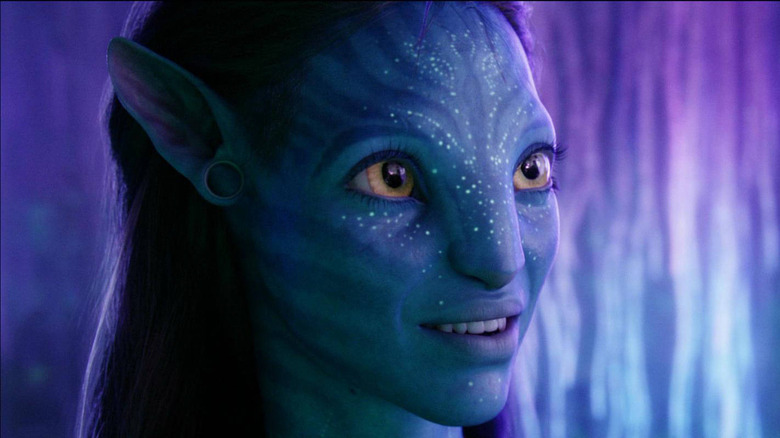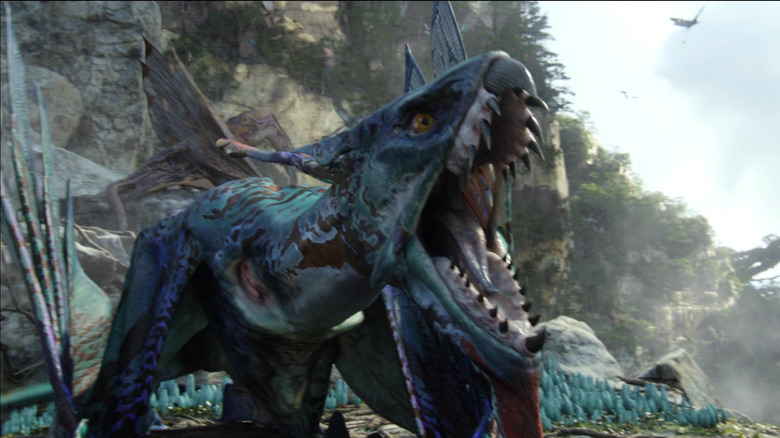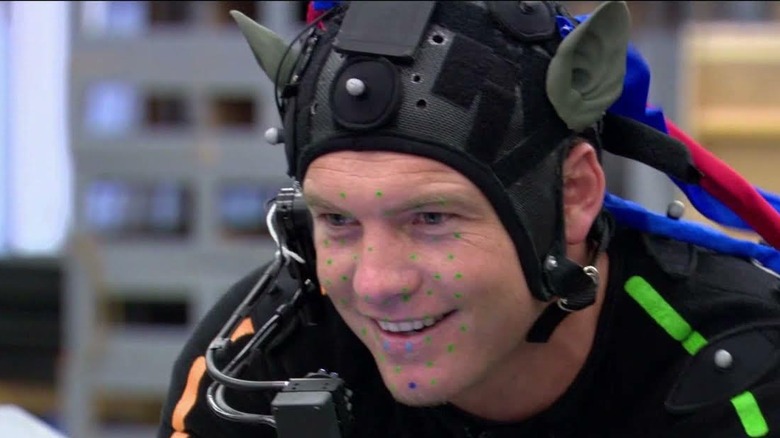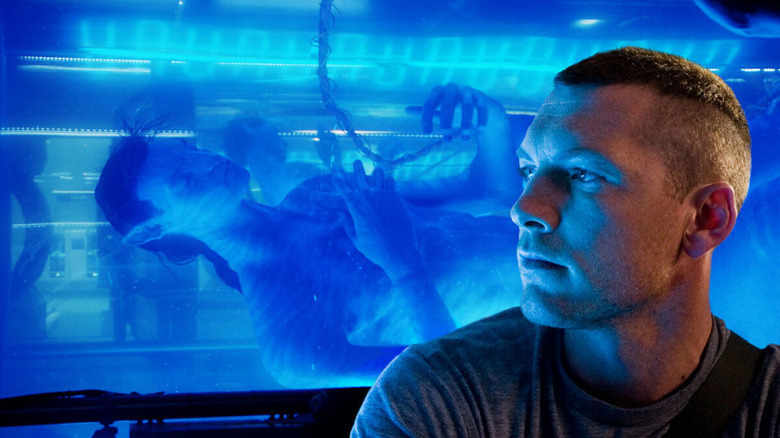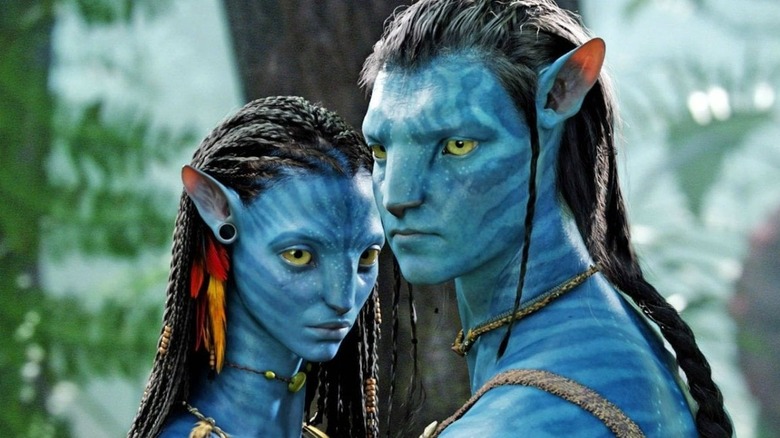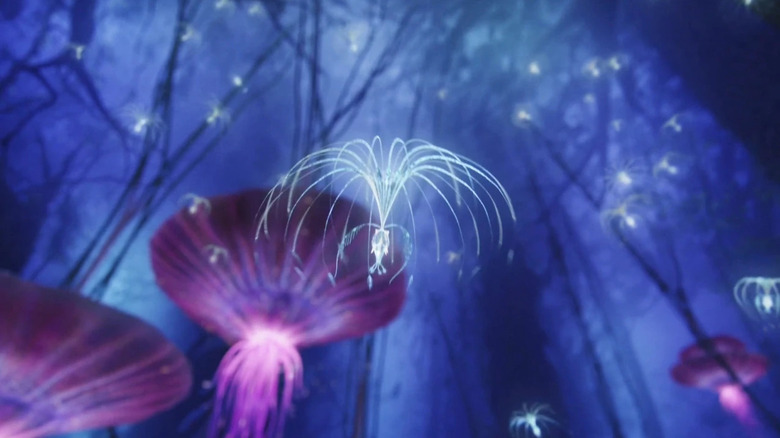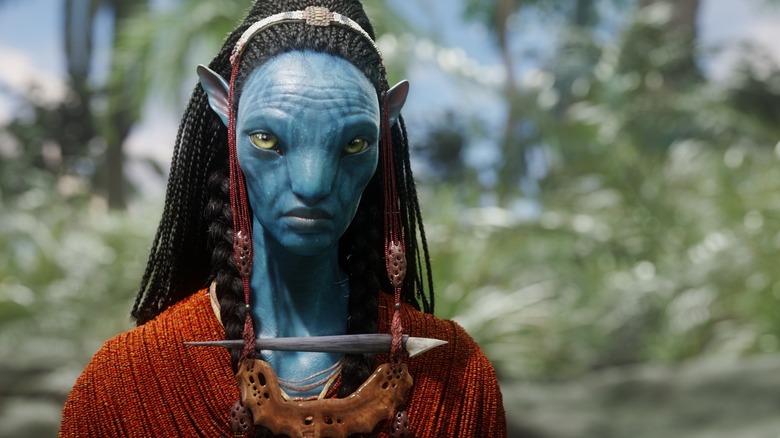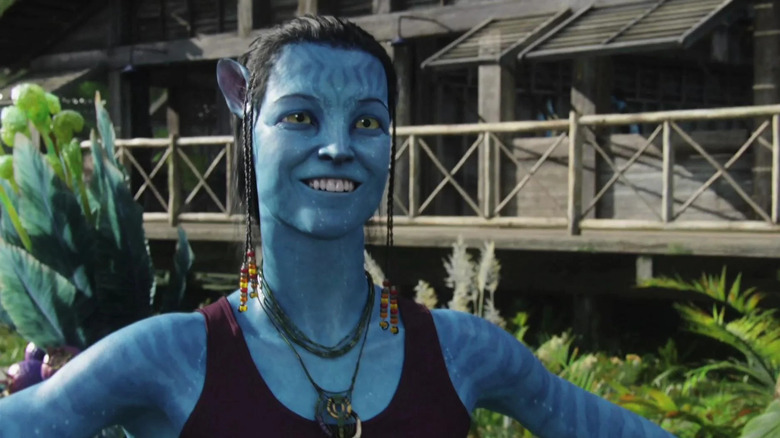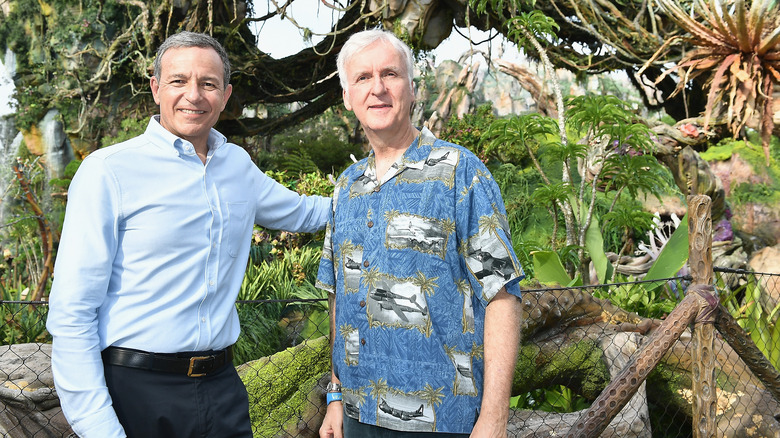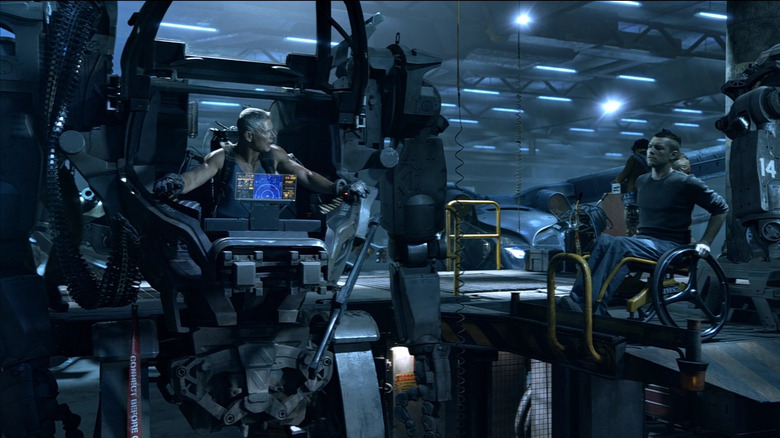Epic Avatar Facts That Will Transport You Back To Pandora
Since the turn of the millennium, sci-fi and fantasy franchises have dominated the global box office and pop culture. "Star Wars," "Harry Potter," "The Lord of the Rings," "The Hunger Games," "Jurassic World," and then some have raked in billions of dollars in ticket sales. These films have also spawned an endless supply of licensed merchandise and conversation on the internet. But curiously, the most epic and fantastical sci-fi movie of all time seems to have gotten lost in the shuffle.
In 2009, "Avatar" premiered and became a phenomenon. Despite its critical and commercial success, the spotlight on Jake Sully (Sam Worthington) and Neytiri (Zoe Saldaña) faded. "Avatar" can't claim to have had the same lasting impact as the above franchises. Many pundits have guessed at the reasons. The simplest answer is this: there hasn't been a new "Avatar" story for 14 years, which means that from 2009 to 2022, "Avatar" wasn't really a franchise.
But that's about to change with James Cameron's upcoming (and long-awaited) sequel "Avatar: The Way of Water." Once audiences revisit Cameron's beautiful and breathtakingly rendered world of Pandora, it's reasonable to think they'll remember what they loved about it so much the first time. Without a constant stream of "Avatar" content, it's easy to forget how it was groundbreaking and a massively ambitious undertaking.
It's inspired by Cameron's childhood fascinations
In the behind-the-scenes documentary, "Capturing Avatar," Cameron explains that the idea for his iconic blockbuster came from his "entire childhood." The writer-director grew up in rural Canada, where he spent most of his free time in the woods, developing a "profound sense of wonder about nature." He was particularly fascinated by "critters" like snakes and frogs and "would catch anything that moved" to keep as a pet so that he could study it.
Cameron is a lifelong fan of fantasy and science fiction. As a child, he enjoyed the writing of Edgar Rice Burroughs ("Tarzan," "John Carter") and the adventure novels of H. Rider Haggard. It's no coincidence that most of those stories are set in exotic jungles, centered around a warring or exploring hero, and contain elements of magical realism. Cameron loved art as much as he loved nature and sci-fi literature, and he used his gifts for drawing and painting to recreate the plants and insects he found in the wild and the fictional worlds he devoured. He's also a vivid dreamer and claims the aesthetic for Pandora came to him in his sleep. These early experiences observing his surroundings and translating his passions into a visual medium prepared him to make "Avatar," a film that best encompasses all his interests.
His imagination had to wait for technology to catch up
Cameron may have had the idea for "Avatar" in his head for "most of [his] life." However, he didn't attempt to make the film until 1995, when he shared a novella-length treatment of the script with his "Titanic" producer Jon Landau. Steven Spielberg's "Jurassic Park," which used digital effects to render its dinosaurs, recently premiered to wide acclaim. That convinced Cameron that he could use "synthetic actors" to tell his story about Pandora and its native beings, the Na'vi. The original plan was to produce "Avatar" through his visual effects company, Digital Domain, at a budget of about $100 million for a 1999 release. No one had made a movie that starred computer-generated humanoid main characters, and Cameron saw that even his cutting-edge technology wasn't up to the task.
He postponed the film's production and focused on deep-sea exploration until the tech — namely, performance capture — caught up. "The Lord of the Rings" trilogy's CGI character, Gollum, partially designed by Joe Letteri (who worked on the dinosaurs in "Jurassic Park" and Peter Jackson's remake of "King Kong"), marked a substantial leap forward. Letteri joined "Avatar's" team and created an even more integrated system that made it possible to illustrate the Na'vi to Cameron's exacting standards. One vital advancement was a mobile camera-like monitor that allowed the director to see what his human actors would look like as CGI Na'vi in real-time while they rehearsed and shot the film.
Studios weren't easily convinced
Even though James Cameron was coming off a $2 billion, Oscar-winning success story in "Titanic," 20th Century Fox was still hesitant about greenlighting Cameron's next film, "Avatar." Yes, "Titanic" was a work of fiction, but people knew about the historical event that inspired its story. "Avatar" was Cameron's original intellectual property. There was no built-in audience for blue aliens who lived on a moon in the Alpha Centauri system. Production would be even more complex and expensive than the dramatic sinking of an 800+ foot long ship.
In 2005, Cameron used some of his money and $10 million fronted from Fox to make a short proof-of-concept reel. He hoped it would convince studio executives that his vision was possible and his story sellable. Fox's executives were intrigued but thought the script could be shorter and the proposed budget smaller. Cameron offered to cut his directing fee in half and forgo some of his residuals if the movie didn't do well in theaters. In mid-2006, Fox passed on "Avatar." Cameron and his collaborators went to Disney, the studio that produced his documentaries. They were receptive, but Fox had first rights of refusal. Sensing interest in the project, the studio partnered with other financial backers to limit their risk and gave Cameron the $237 million he wanted.
Some A-list actors missed out on the lead role
Once "Avatar" had the backing of the studio, Cameron and company began casting the lead role of Jake Sully, the initially apathetic, injured ex-marine who trades his wheelchair for the ten-foot body of a blue alien. Whoever played Jake would have to perform in the film's live-action sequences as the human iteration of the character and Avatar form via motion capture — an exciting opportunity in intimidating and uncharted territory. Cameron's first choice for Jake was Matt Damon, following appearances in Martin Scorsese's "The Departed" and the Ocean's Eleven and Bourne Identity franchises. He offered the actor a contract worth 10 percent of the film's revenue, but Damon — who was already committed to filming "The Bourne Ultimatum" — turned him down. Approximately, Damon's loyalty to Jason Bourne cost him $280 million.
Cameron considered several actors who either were or went on to become household names. Jake Gyllenhaal infamously passed on "Avatar" to star in the critically panned "Prince of Persia: The Sands of Time" instead. Three of Hollywood's Chrises — Evans, Pine, and Pratt — also tried out for Jake Sully before they entered the MCU and DCEU, as did Channing Tatum. Pratt's audition didn't go well, nor did Pine's. Both stars didn't have the confidence or experience that the casting directors wanted. Evans and Tatum made it to the final round, but the job went to newcomer Sam Worthington, who dropped his Australian accent for the part.
The Na'vi design presented a challenge
"Avatar" has many fantastical creatures — equally beautiful and terrifying — due to years of research and drafting. (Curious fans can check out this process in this behind-the-scenes documentary.) The banshees, direhorses, and thanators' designs stemmed from real-world animals — eagles, horses, and panthers — but with alien modifications that are biologically plausible. Cameron cited poison dart frogs and tropical reef fish as informing Pandora's species' bold coloring. Like Earth, this strange moon would have a unique food chain, with apex predators and herding herbivores. What distinguishes Pandora's wildlife is that they're (mostly) hexapods, having six appendages instead of four.
The Na'vi had to be just as otherworldly-looking as the rest of Pandora's flora and fauna, but their design presented Cameron and the film's artists with an additional challenge. At the heart of "Avatar" is a cross-species love story between human Jake Sully and Na'vi Neytiri. For the movie to work, the romance had to too. Cameron wanted Pandora's natives to look entirely alien, but they also had to be attractive to Jake and the audience. He conceived of something with blue skin, cat-like ears, lemur-like eyes, and an amphibious form. Early drafts were too animalistic and off-putting, while subsequent drafts looked too much like blue people. Animators, working with physical models and digital mock-ups, created between 50 and 60 versions of Neytiri before settling on that character's final appearance.
A botanist helped bring Pandora to life
Arguably, the most memorable thing about "Avatar" is the production design of Pandora's untouched natural forests. To bring the mystical landscapes to life, Cameron relied upon the expertise of a botanist, Dr. Jodie Holt, who consulted on the film. Holt is the chair of the department of botany and plant sciences at the University of California, Riverside, and a field biologist who studies invasive species of weeds. At Cameron's request, she incorporated as much science into the botany of Pandora as possible. She reasoned that a moon with a strong magnetic pull, low gravity, and a dense atmosphere might have supersized plant life (like Pandora's incredibly tall trees) that stretched into the available daylight. The ecosystem underneath the canopy would be dark, so the plants might evolve to be bioluminescent.
Holt didn't design the plants, but her input contributed to Pandora's vibe — an inviting combination of being freaky, lush, and scary. She also helped flesh out the character of Dr. Grace Augustine (Sigourney Weaver), an exobiologist spearheading the Avatar program. Holt gave Cameron and Weaver advice about scientists in the field, their dress, and their work. But not all of her counsel made it into the film: Botanists wouldn't smoke near lab samples or stick syringes into tree trunks.
Consultants helped to create a culture for the Na'vi
Although "Avatar" is deeply rooted in the tropes of futuristic sci-fi, Cameron invented a Pandora civilization under threat from the Earthlings' mech suits and assault ships. His imagined society was tribal and neolithic, so costume designers Deborah Scott and Mayes C. Rubeo had to make the Na'vi's various garments and adornments (physically and digitally) from Pandora's natural materials — keeping with their utopian environmental philosophies. Cameron brought in consultants to craft a rich culture for the Na'vi, only some of which made it to the screen.
CalArts ethnomusicology expert Dr. Wanda Bryant worked with composer James Horner to invent instruments and soundscapes for the Na'vi. They imagined how music fits into their culture — from hunting and weaving songs to funeral rites. The result was a global fusion that included Swedish cattle herding calls, Indian folk dances, Vietnamese and Chinese work songs, Central African vocal techniques, and more. Linguist Dr. Paul Frommer of the University of Southern California created a Na'vi language from scratch. Frommer used about 30 or 40 words that Cameron had already made up, plus the concept of apostrophes separating syllables as a starting point. He took the Na'vi's physiology into account and focused on "ejective" or popping sounds not commonly found in western speech. Frommer's Na'vi language included thousands of new words and grammatical rules for their usage, which he taught the actors.
There's an in-joke about Cameron's environmentalism
Cameron has suggested that "Avatar's" overt environmentalist themes were one of the early sticking points between him and studio executives, particularly the then head of 20th Century Fox, Peter Chernin. The filmmaker has long been an outspoken advocate for policies aimed at addressing climate change and other environmental issues. In his personal life, he became a vegan and has invested in plant-based food companies. In his art, he explores the impact of human existence and scientific innovation on the natural world, for better or worse. Cameron claimed that Chernin liked his original script for "Avatar" but asked if the writer-director would be willing to cut out the "tree-hugging" and "hippie" stuff.
He was not. Cameron felt that he was finally at a point in his career where he shouldn't have to sacrifice his creative and philosophical integrity. He felt sure that "Avatar" would make money regardless of his unequivocal environmentalist point of view and proceeded to make the movie he wanted to make, with "Avatar's" anti-colonialist and anti-resource exploitation themes in place. But he added a line that referenced the studio note. When Jake learns about the Na'vi from Neytiri and records his thoughts for the Avatar project through video diaries, at one point, he dismissively says, "I really hope this tree-hugging crap isn't on the final." This line can be read as Cameron's way of letting Chernin know he got the last laugh.
It's still the reigning box office champ
"Avatar" remains at the top of the all-time box office leaderboard, having made $2.9 billion (and counting), putting it just ahead (if "just ahead" means $100 million) of what's been its main competition for the last few years, "Avengers: Endgame." But "Avatar's" journey to the number one spot took a different path than most modern blockbusters. The capstone to the Infinity Saga made $1.2 billion in its opening weekend (nearly half of its eventual total), including more than $350 million in the United States. Marvel movies must bring in at least $150 million in their opening week to be successful. Most recently, "Doctor Strange in the Multiverse of Madness" opened to $187 million, "Thor: Love and Thunder" opened to $144 million, and "Black Panther: Wakanda Forever" opened to $181 million domestically.
In contrast, "Avatar" made $77 million in America and $242 million worldwide when it premiered in 2009. That was better than expected for a non-franchise property. But its haul still fell short of the December record for "I Am Legend," and those numbers pale to an average Marvel movie's performance. 2008's "Iron Man" and "The Dark Knight" easily outgrossed "Avatar" in their respective debut weeks. Two factors propelled "Avatar" to eventual victory. The film's good word of mouth and rewatchability kept it in the top spot for an impressive seven weeks and played in theaters for an incredible 48 weeks. A 2022 re-release gained the reigning champ an extra $30 million.
Fans wanted to experience Pandora for themselves
Some people who saw "Avatar" (especially those repeat viewers) became so transported by the world Cameron created they had a hard time readjusting to life on Earth. Fan forums and message boards were full of users complaining that they were experiencing the "Avatar" blues after realizing they couldn't actually go to Pandora. Luckily, Disney CEO Bob Iger had a plan to make their wildest dreams come true. In 2011, Iger approached Cameron about adding an "Avatar"-themed land to Walt Disney World. The director and Landau were on board, especially once they understood the project's scope. Pandora: the World of Avatar wasn't going to be a ride but an immersive experience.
Disney didn't yet own 20th Century Fox, so a licensing deal had to be worked out that included fees and percentages of merchandise sales to be paid to Cameron's companies and partners. The $500 million, 12-acre expansion to Disney's Animal Kingdom opened in 2017. Guests gawked at what appeared to be Pandora's iconic floating mountains. They could fly on the back of a banshee on a 3D ride called Avatar: Flight of Passage. They could experience the bioluminescent rain forests for themselves on Na'vi River Journey. Fans could hike through the imagined landscapes, dine, or shop at themed restaurants and stores. Pandora: The World of Avatar was a blockbuster in and of itself; it increased park attendance, and its attractions remain exceedingly popular.
Cameron faced off against his ex-wife at the Oscars
Since his previous film, "Titanic," had won 11 Oscars – including best picture and best director — there was automatic awards buzz for his long-awaited follow-up, "Avatar." The movie's favorable reviews and box office endurance certainly helped its case, as did the extent to which voters were impressed with Cameron's technological breakthroughs and visual effects achievements. But "Avatar" also had prejudices to overcome that didn't affect "Titanic." Generally speaking, the Academy doesn't often go out of its way to honor genre films, particularly when it comes to science fiction. Similarly, Hollywood still didn't know what to make of motion capture performances.
Come Oscar time, "Avatar" was nominated in nine categories, the same number received by its competition, "The Hurt Locker." That film, about a bomb squad deployed during the Iraq War, was directed by Cameron's ex-wife, Kathryn Bigelow. The budget for "The Hurt Locker" was $15 million — less than a tenth of the cost of "Avatar." The film had done well with critics but failed to find much of an audience, making a paltry $17 million. Just as "Avatar" and "The Hurt Locker" emerged as the best picture frontrunners, Cameron and Bigelow emerged as favorites for best director. Bigelow then became the first woman to win an Oscar for best director. But the ex's relationship was more collaborative than competitive. Cameron and Bigelow screened their films for each other before they hit theaters, and Cameron thought Bigelow deserved the recognition.
